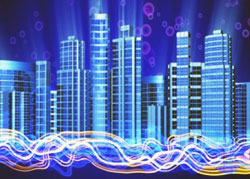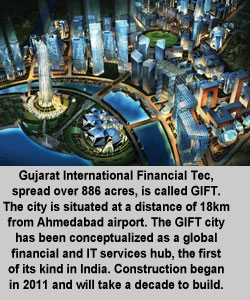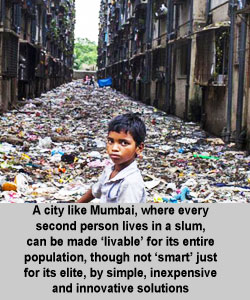
 . . |
Smart cities in India ON THIS PAGE: The origin of the smart city concept ||| Smart cities in India ||| What is a smart city? ||| Definitions of smart city ||| Establishing smart cities ||| |
|
FRONT PAGE About us   ALSO BY P. M. APTE World’s most famous slum must be remodelled not redeveloped More Gandhinagar’s unique layout threatened by urban planners More India needs futuristic policies to manage economic growth and rapid urbanization More Mumbai in urgent need of reforms to governance and management More |
 Smart cities – a delusion Smart cities – a delusionof misplaced priorities By Prakash M Apte, Urban Development Consultant 14 January 2016: According to a study by MIT Media Lab, in the future, cities will account for 90 per cent of the global population growth, 80 per cent of wealth creation and 60 per cent of total energy consumption. Developing better strategies is therefore imperative for improving the living environment in our existing cities. Expanding current metropolises by rational planning, and refurbishing infrastructure and amenities in existing cities can be intelligent and sustainable options but are highly challenging in the context of the meager fiscal and other resources and lack of political will. The policymakers are, instead, looking at creating ‘smart cities’ for the future! The origin of the Smart City concept The concept of ‘smart cities’ originated at the time when the world was facing one of its worst economic crises. In 2008, IBM began work on a 'smarter cities' concept as part of its Smarter Planet initiative. By the beginning of 2009, the concept captivated the imagination of exasperated urban planners in the developing world. Having utterly failed to design, execute and implement city planning policies to manage accelerating urbanization, these planners realized that the promotion of the ‘smart city’ concept would provide the path of least resistance that promised the illusion of instantaneous panacea to disgruntled and ill-informed voters and create a new ‘planning’ category that miraculously addressed decaying infrastructure, non-existent civic services and amenities, and urbanization gone awry simply by ‘bolting on’ an additional layer of ‘information technology’. Furthermore, fiscal profligacy could be pursued with even more abandon under the ‘smart’ mantra backed up with a slick PR campaign. This distorted and misguided ‘vision’ of a ‘smart city’ would not even have to deal with the ‘law of unintended consequences’; simply because its implementation would make no difference and would be inconsequential, in the form of yet another western transplant unsuited to a developing country. Countries like South Korea, UAE and China began to invest heavily into their research and formation. Today, some precedents exist, such as those in Cairo, Málaga, Malta, the Songdo International Business District near Seoul, etc.  Smart cities in India Smart cities in IndiaThe Union government budget of 2014 has earmarked Rs.7,060 crores (more than 100m US$) to set-up 100 new ‘smart cities’. The cities proposed to be made ‘smart’ include Kochi in Kerala, Ahmedabad in Gujarat, Aurangabad in Maharashtra, Manesar in Delhi NCR, Khushkera in Rajasthan, Krishnapatnam in Andhra Pradesh, Ponneri in Tamil Nadu and Tumkur in Karnataka. But more names are being added as planners and politicians alike jump on the bandwagon of smart cities! Many of these cities will include special investment regions or special economic zones with modified regulations and tax structure to make them attractive for foreign investment. This is a necessary step as much of the funding for these projects will have to come from private developers and from abroad! Wave Infratech, a real estate developer, is already making a ‘smart city’ in Ghaziabad (Uttar Pradesh) and has engaged IBM for the project. Named Wave City, it is to have “a central command centre which will integrate and interconnect information from various systems and services within the township to improve safety, prevent and anticipate problems and improve the quality of life of residents.” For example, a resident’s smart device (can a majority of citizens in poverty access these without a smart device?) will be alerted to current traffic conditions or residents can check parking availability or changes to traffic conditions due to large sporting events or in the event of a natural disaster like flooding. Does it not mean that it will be a city only for the ‘elite’, (very similar to an IT institution campus) and the poor will be banished from residing there? In spite of income invariant market penetration of smart phones, there remains a large disconnect between the ease of access to services and amenities versus the capability of providing access – or indeed – the absence of having any services to access at all. Having the former at the expense of the latter is akin to putting the proverbial cart before the horse. More than 60 per cent of the population in most cities in India live in slums and have a very low monthly income. How will these residents be helped by such an egregious misinterpretation of a ‘smart’ city when there exists none to negligible adequate housing, water, uninterrupted power supply, garbage disposal and sanitation, good and conveniently located parks, playground, schools & medical facilities? The concept of the ‘smart city’ is very amenable to being conveniently hijacked by callous vested interests that are more interested in creating an even more digital divide between their ‘islands of affluence’ and the sea of poverty. Paying mere lip service to the genuine ‘smart city’ concept allows a public relations razzmatazz campaign to get the socially, politically and economically disadvantaged/disenfranchised on board without actually improving the ability to provide basic services! What is a smart city? ‘Smart city’ is an applied technology term and relates to an internet-enabled, broadband, wireless and digital concept for the future of cities. The concept, as the next sequential stage in the process of urbanization has become quite ‘fashionable’ in recent years, with the aim of drawing a distinction from the terms ‘Digital City’ or ‘Intelligent City’. Its main focus is still on the role of ICT (Information- Communication Technology) infrastructure, though research has also been carried out on the role of human capital (education, social and relational capital and environmental interest) as important drivers of urban growth whether ‘smart’ or not. The availability and quality of the ICT infrastructure does not - by itself - define a smart or intelligent city. Another driver is human capital and education and learning in urban development. It has been shown, for example, that the most rapid urban growth rates have been achieved in cities where a high share of educated labour force is available. A smart city is not necessarily a sine qua non for attracting a skilled educated labour force. Innovation is driven by entrepreneurs who innovate in industries and products which require an increasingly more skilled labour force. Because not all cities are equally successful in investing in human capital, an educated labour force is spatially clustering over and within cities over time. It turns out that some cities, which were in the past better endowed with a skilled labour force, have managed to attract more skilled labour, regardless of their being classified as smart cities. On the other hand, designating and making a city smart may still fail to attract an educated skilled labor force due to inadequate and/or ad hoc designed infrastructure, sanitation, housing, educational and recreational facilities Definitions of smart city The Vienna University of Technology defines a ‘smart city’ as: “A city well performing in a forward looking way in economy, people, governance, mobility, environment and living, built on the smart combination of endowments and activities of self-decisive, independent and aware citizens.” This description puts intelligent and enlightened people at the heart of the vision. It does not restrict itself to the focus on its digital and connected infrastructure. ‘Smart cities’ have three enablers, the first and most obvious one is technology infrastructure. But the two other enablers are soft and less obvious and pre-requisites- institutional and human enablers. A 'smart city' is supposed to be an urban region that is highly advanced in terms of overall infrastructure, sustainable real estate, communications and market viability. But are these not prerequisites of rational urban growth & development? A smart city is supposed to be a city where information technology is the principal infrastructure and the basis for accessing (as opposed to providing) essential services to residents. There are many technological platforms involved, including automated sensor networks and data centres. This underlines my contention that ‘smart cities’ are for the Elite only! In a ‘smart city’, economic development and activity is sustainable and rationally incremental by virtue of being based on success-oriented market drivers such as supply and demand. Is this not also an essential requirement of normal urban development? A ‘smart city's’ core infrastructure is information technology, where a network of sensors, cameras, wireless devices, and data centres forms the key infrastructure providing essential services. How many of the cities of the developing world with over 60 per cent of the population living below the poverty line can benefit this population segment from the advanced infrastructure? Being environmentally friendly, ‘smart cities’ use sustainable materials for building facilities and reduce energy consumption, as should any urban centre as a human settlement. So, what is the concept of a smart city? Will it be something similar to the Songdo International Business District coming up on 1,500 acres of reclaimed land near the Incheon international airport in South Korea? Or will it be sector-focused like in Singapore where, with heavy investment in its public transportation infrastructure, success was achieved in creating one of the most modern, affordable and highly-used public transport networks in the world? (Close to three million people use Singapore's bus system every day; over one-and-a-half million use the train, in the process efficiently addressing the huge traffic congestion issue.) But is this also not required of any city like Mumbai in India (without being ‘Smart’) that has a population of more than 12.5 million where 80 per cent of its people depend on public transport? Without prioritizing public over private transport in the form of dedicated or exclusive lanes, clockwork schedules, expanded services and improved passenger convenience and comfort, installing GPS systems in buses that run on unpredictable schedules enables the commuter to ‘predict their unpredictability.’ The benefit of predicting an unpredictable event in real time accrues negligible benefit to the commuter. There is no single, comprehensive definition of what a ‘smart city’ means. Identification of ‘smart cities’ can be based on five factors: broadband connectivity; a knowledge-based workforce; digital inclusion; innovation; and marketing and advocacy. Shared infrastructure, broadband, end-user services and common service centres are supposed to be key features of a ‘smart city’.  Establishing smart cities Establishing smart citiesSo, are ‘smart cities’ simply places where a smart phone can run all the errands for a citizen? Will they be cities that produce both the energy resources and food they need and hence “sustainable”? Or are they modern urban places with infrastructure like Silicon Valley? Or just very hi-tech cities with flying cars and floating buildings? As an experienced urban planner the question that nags me is, in the context of cities like Mumbai, how will installing a digital server help create civic infrastructure needed to house the poor? How will this improve quality of housing and its affordability in the city? How will the cities get enough electricity to power all this digital gadgetry when we cannot even currently supply 24x7 electric power to light homes? How will it help overcome lack/deficiency of sewage and water supply system? One needs physical infrastructure in place first to digitally manage it. Where are the funds for these? In the absence or paucity of basic amenities, the “smart city is a delusion of misplaced priorities and serves as a convenient public relations escape from the failure to provide basic amenities to the urban population in the developing world! A city like Mumbai for example can be made ‘livable’ for its entire population, though not ‘smart’ just for its elite, by simple, inexpensive and innovative solutions for most of its issues like shelter, transportation, open spaces, community facilities and physical infrastructure as detailed in my book, Urban Growth Strategies: Mumbai lessons”(2013). There are lessons to be drawn from green-field cities like the GIFT city near Ahmedabad and from private initiatives like Lavasa near Pune in Maharashtra. We need to address some important questions, particularly in the Indian context, when trying to make our cities ‘smart’: • How is resource availability to be ensured? Will it essentially be private-public partnership? If so, sufficient clarity on its components would be essential, considering the fact that urban PPPs have really not taken off in India. What would be the role for technology providers, since it is they who would dominate supply? (hence the fear expressed by some that these cities would become a fiefdom of corporate magnets) And would they ultimately dominate the city as is feared by some opponents of smart city concept in Mumbai? • What will be the role of state governments? A proper structured mechanism for their participation will have to be clearly stated right at the beginning, as these projects cannot be allowed to become victims of circumstances - as they tend to become quite often. • How is the process to be led and coordinated at the local government level? Since in India we do not have empowered mayors, and local bodies have a limited mandate, how is the process to be taken forward given that it will cut across sectors within and beyond the jurisdiction of the urban body. • A key aspect to be carefully addressed is that of inclusiveness. What systems will ensure that access is easy even for economically weaker sections, and equal participation is facilitated for them so that planning for the so called smart city is inclusive and not only for the elite. • How can we create technical capacity at the local body level to drive the entire process? • What will be the role of soft infrastructure particularly the ICTs • How will the smart city take advantage of the of the opportunities that the ICTs offer to increase local prosperity and competitiveness which implies integrated urban development based on multi-actor, multi-sector, and multi-level perspectives. • How could a smart city offer ample opportunities for sustainable, user-driven ‘intelligent’ services • How can all citizens monitor the pollution concentration in each street of the city or get automatic alarms when the pollution level rises a certain level will it enable the authorities to optimize the maintenance of parks or the lighting of the city? Can water leaks be easily detected or noise maps obtained? Can garbage bins send an alarm when they are close to being full? Quite a few issues can be addressed without a city being ‘smart’: Vehicle traffic can be monitored in order to modify the city lights in a dynamic way. (I have seen this in execution in the city of Miami, Florida, USA without it being called a ‘smart City’.) Traffic can be reduced with systems that detect where the nearest available parking slot is. Motorists get timely information so they can locate a free parking slot quickly, saving time and fuel. Urban flooding can be mitigated by using distributed rainwater harvesting infrastructure to reduce peak flows and maximize wet weather capture. This enables wastewater treatment facilities to treat storm water runoff. How well developed cities (not necessarily ‘smart’ ones) can transform citizen’s lives: Our cities can be ‘smart’ if, as urban planners, politicians, administrators and decision makers, we follow the following principles in our urban planning and plan implementation viz. (1) Effective governance: Our cities must see a greater involvement of stakeholders in policy framing and implementation. Technology should enable greater participation and transparency. Communities should be able to keep in mind the long-term interests and make wiser choices in the use of resources. (2) Enlightened inhabitants: Citizens must develop a habit of participating in the life of the community and consider participation not only as a choice, but as a right rather than a burden. They should be guided by principles of pluralism and harmony. (3) Easy mobility: Our cities must embed mobility in the fabric of the city’s infrastructure and weave it in its cultural ethos. Apart from other physical infrastructure, a safe and efficient public transport system is a must. (4) Happy living: The ability to access housing, healthcare, education and leisure facilities easily and at an affordable cost is a critical component. At the planning stage, planners must factor in cultural infrastructure, safety and quality of buildings and social cohesion. (5) Amenable environment: While planning, living space must be envisioned in the light of a subtle balance between built-up space and green areas, water resources, pollution control and use of resources in a responsible and environment friendly way (for example, use of renewable energy, rain-water harvesting, green initiatives and so on). (6) Optimal economy: In such an economy, innovation must be the driving force that allocates resources in the right direction. ‘Smart city’ should thus, be a synonym for good urban planning that an urban planner is expected to practice ever since the days of Ebnezer Howard and not an exclusive entity for the elite. The term “Smart City’ should therefore represent a culmination of deliberately planned urbanization. If we can just get clean, motivated administration for our urban areas and garner adequate resources to plough back in the infrastructure of our existing cities those cities will eventually become smart! Rational urban planning, adequate physical & social infrastructure and financing with stringent implementation and management is all that is necessary! The term ‘smart city’ can then legitimately be applied without it appearing to be a ludicrous or callous misnomer. Follow @City_Mayors |